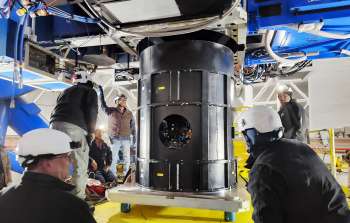sci24065 — Announcement
Gemini North Returns From Shutdown
December 16, 2024
Gemini North entered its 2024 maintenance shutdown on Monday 14 October. The planned work centered around annual maintenance of the acquisition and guidance unit (A&G), which lies at the heart of the Instrument Support Structure and houses the peripheral wavefront sensors and the various mirrors that direct light into instruments and to and from the Altair AO system. In addition, we organized a visit by a contractor (Heidenhain) to inspect and adjust encoder tapes and sensor heads in the A&G and on the telescope mount, and to comment on their condition.
We replaced glycol hoses in the azimuth wrap beneath the telescope, remedying a failure in semester 2024A which left us using backup cooling lines. We tested some new electronics for motion control in the A&G, as an early stage of a project to remedy the obsolescence of significant parts of the system. Finally, we used the opportunity of the telescope downtime to do some instrument maintenance, including on GMOS optics and the MAROON-X Laser Frequency Comb (LFC).
We are of course heading into the northern winter, so over the weekend of 26 October snowfall arrived on Maunakea, costing us one day because of lack of access to the summit ridge. The weather mostly cooperated thereafter, though on 4 November we had to abandon the summit early when rainfall began to render the cinder road unsafe.
All in all, the shutdown was both successful and completed on schedule. In the course of the few weeks we learned a lot about the tape encoder systems on the A&G and elsewhere from the manufacturer, did significant maintenance on the A&G mechanical and electronic systems, inspected and cleaned the various optics and verified that their reflectivity was still good, replaced the failed glycol lines, and did useful testing on the A&G amplifiers.
With the A&G restacked and back into the telescope, the bottom-port instrument (also the MAROON-X front-end) was reinstalled and we were ready to restart as planned on 13 November. The first night back on-sky was impacted by (i) a power cut in Hilo which lasted almost an hour; (ii) high winds and, later, 100% humidity on the summit ridge of Maunakea; and (iii) a power cut on the summit in the early hours on the morning of the 14th, after we had already called the night. We recovered from the latter in time for night operations on the 15th and got our first photons (onto a wavefront sensor) that evening, before again being closed by the weather. The star came in within a few arcseconds of the Cass Rotator nominal center. Since then we’ve had a mix of high cloud and clear, enabling both science and engineering tests; we’ve verified most of the systems and lookup tables — only a few remain to be completed — and science data have been flowing once again. Gemini North is fully back in action.
About the Announcement
| Id: |
ID
sci24065
|

